ROOF GARDENS |
ROOF GARDEN Photo Gallery |
Frequently Asked Questions on Roof top gardening  |
Introduction:
Green roofs offer several ecological, economic and other benefits to the urban environment. These include mitigation of the urban heat island effect, provision of natural habitat for plants and animals, reduction of dust, smog and noise levels, improved storm water management and water quality and reduced energy use. Green roofs also provide owner incentives such as increased life of roofs and enhanced quality of life. |
| Roof garden for various purpose |
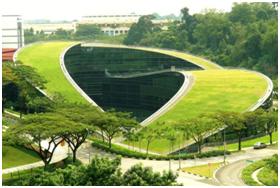 |
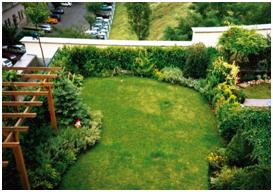
|
| Public buildings |
Home - roof top garden |
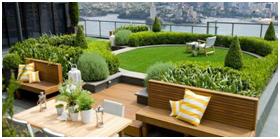 |
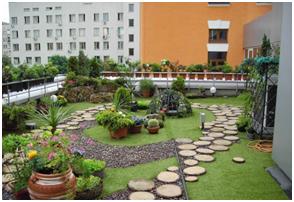
|
| Roof top restaurants |
Recreational roof garden for apartments |
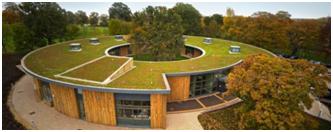
|
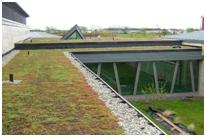 |
| Extensive green roofs for Energy efficient buildings |
Types:
Green roof substrate is the key component of any green roof system. Green roof is divided into two types.
- Extensive Roof / Green roofs
- Intensive Roof(Roof Garden)
| Extensive Roof / Green Roofs |
Intensive Rroof (Roof garden) |
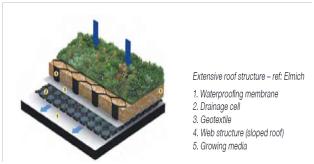 |
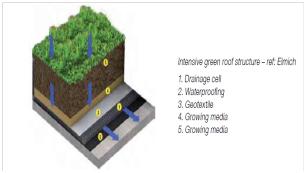 |
This classification is based on the depth of the substrate (growing medium) used. If it is less than 15 cm, it is called as extensive green roof. If the depth is more than 15 cm, it is called as intensive roof garden.
| CHARACTERISTIC |
EXTENSIVE |
INTENSIVE |
| Growing Medium Depth |
150mm or less |
>150mm |
| Accessibility |
Often inaccessible |
Usually accessible |
| Fully saturated weight |
Low
48.8-170kg/m2 |
High
244-1500 kg/m2 |
| Plant diversity |
Low |
Greatest |
| Cost |
Low |
High |
| Maintenance |
Minimal |
Varies, but is generally high |
|
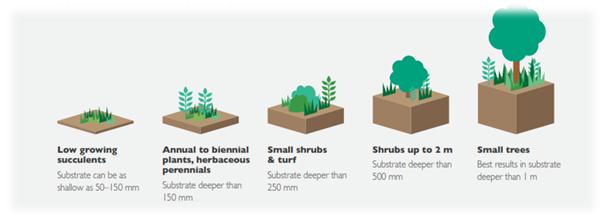 |
Building and installation of roof gardens:
- Layers of roof garden
- Water proofing
- Drainage layer
- Growing media
- Plant selection
- Irrigation
Layers of roof garden:
Roof garden employs a multilayer system, including a waterproof membrane, drainage layers, geotextile layer, specialised soil medium, soil stabiliser, and a selection of appropriate plant species and varieties that best tolerates the often extreme environmental conditions found in a rooftop setting. |
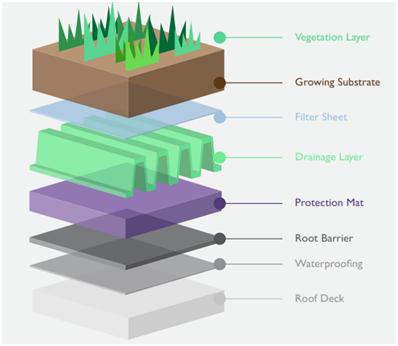 |
Installation: |
| 1 |
Roof deck water proofing |
| 2 |
Protection layer is laid to avoid root penetration to the concrete roof |
| 3 |
Installation of draincells |
| 4 |
After installation of drain cells |
| 5 |
Installation of filter layer- geotexile sheet |
| 6 |
Substrate is poured over the sheet and leveled |
| 7 |
Design and planting |
| 8 |
Vegetation after planting |
|
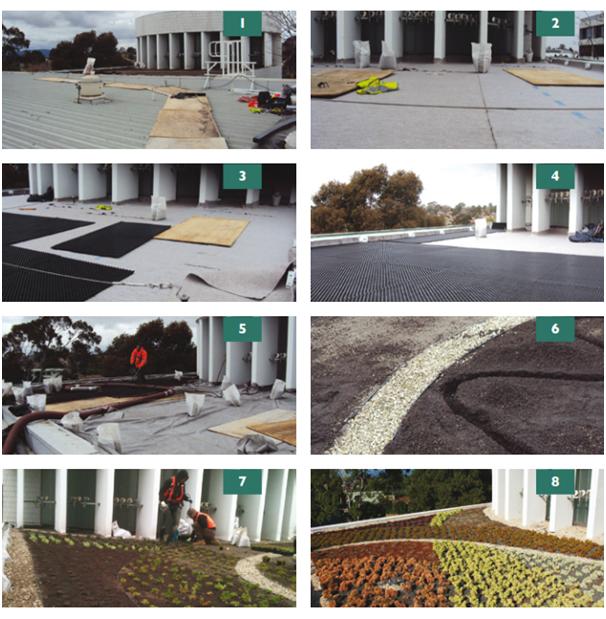 |
Tray system (extensive green roofs):
|
Water proof membrane:
Water proofing is the area that is responsible for the most litigation. The structure of the building will determine water proofing design and installation. There are many kinds of waterproof membrane. Some membranes have added root retardants which acts as root barrier.
Drainage layer:
The purpose of drainage systems is to facilitate water runoff from the roof to prevent structural collapse and plants from drowning while retaining enough moisture to support plant life. The roof drainage should be integrated into the building drainage system. Drainage facilities must be capable of collecting both overflow from the drainage course and surface water from the vegetation support course and of conveying it away.
The drainage system should be permanent and cover the entire roof area. Water retention may be desirable as an environmental mandate. This may require:
- Increased drainage cup size (versi cells)
- A water retention layer
- Engineered growing medium
|
|
Filter sheet:
Drains water and retains the growing media and roots
Growing medium:
Growing medium selection is critical to the long and short term success of a green roof. The following factors should be considered for selecting growing medium
- Load bearing capacity
- Slope
- Climate
- Drainage
- Plant species
Natural mineral components of roof garden substrate include sand, clay, lava, pumice, gravel, etc. Artificial or modified mineral components such as perlite, vermiculite, etc., are used in roof garden. Organic materials such as peat, composts are also added to the substrate formulation.The light weight soil amendments reduce substrate weight and support plant growth. The pH should be 5.5 -8. the air content and water storage capacity should be more than 20% and 45% by volume. |
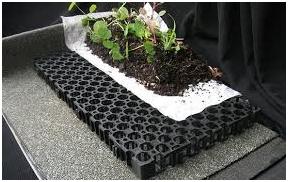 |
|
Plant species selection:
Plant species selection is dependent on a number of factors:
- Maintenance investment and resources
- Aesthetics
- Function
- Climate and weather
- Structural load bearing
- Roof type
- Plant growth rate and nutrient demand
- Supply and availability
Different depth of the substrate supports different vegetation. For example, in extensive green roof, moss and sedum can be grown in 4 – 10 cm depth and moss, sedum and herbaceous plants can be grown in 5 – 11 cm depth. In a depth of 15 – 25 cm, grass and herbaceous plants can be grown.
In roof garden, lawn shrubs, coppices and trees can be grown. Trees can be grown in more than 50 cm depth of the growing medium.
For roof garden, attention needs to be paid to the following factors:
- Certain individual varieties, particularly evergreens are not completely winter hardy and where the plant cover is of limited density.
- Shrubs and coppices in exposed positions must be able to withstand the wind
- Certain plants are sensitive to reflected light and thermal build up.
- All vegetation is sensitive to airborne chemical and exhaust contamination, also to warm and cold air emissions.
|
| Low growing succulents |
Sedums, Aptinia cordifolia, Portuluca, Crassula spp |
| Perennials |
Alternenthera, Marigold |
| Ground covers |
Setcreasea purpurea, Wedelia , gourds |
| Large succulents |
Aloe, Jade plant |
| Grasses |
Zoysia –korean grass, Bermuda grass, Ornamental grasses |
| Herbs and vegetables |
Thyme, Rosemary, All greens |
| Trees ( For intensive roof gardens) |
Plumeria alba, Pomegranate, Citrus trees, Palms |
Irrigation:
Additional watering should be carried out regularly at roof garden. This may be provided by using a hose, sprinkler type or drip type hoses, or overhead irrigation system or automated watering system.
Benefits:
- Aesthetic effects
- Acts as natural insulation for hot and cold air and a save energy for your building
- Reduces CO2 levels and increases oxygen and improved air quality
- Improves thermal insulation and energy efficiency
- Provides protection to buildings from adverse temperature and hence improves the life expectancy of the buildings
- Mitigate urban island heat effect
- It holds rain water, providing food and shelter for wildlife
|
Source:
Department of Floriculture and Landscaping
TNAU,Coimbatore-3. |
|
|
|
|

